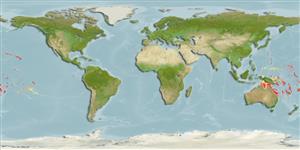Common names from other countries
>
Eupercaria/misc (Various families in series Eupercaria) >
Scaridae (Parrotfishes) > Scarinae
Etymology: Scarus: Greek, skaros = a fish described by anciente writers as a parrot fish; 1601 (Ref. 45335).
More on author: Steindachner.
Environment: milieu / climate zone / depth range / distribution range
Ekologi
marina revassocierade; djupintervall 1 - 50 m (Ref. 37816). Tropical; 32°N - 32°S, 132°E - 124°W
Pacific Ocean: Ryukyu Island to the Line and Ducie Islands, north to southern Japan, south to Lord Howe and Rapa Islands; throughout Micronesia.
Size / Vikt / Age
Maturity: Lm ? range ? - ? cm
Max length : 60.0 cm TL hane/ej könsbestämd; (Ref. 9710); common length : 41.0 cm SL hane/ej könsbestämd; (Ref. 37816)
Short description
Bestämningsnycklar | Morfologi | Morfometri
Taggstrålar i ryggfenan (totalt) : 9; Mjukstrålar i ryggfenan (totalt) : 10; Taggstrålar i analfenan: 3; Mjukstrålar i analfenan: 9. This is the only Scarus in which one of the middle dorsal rays of terminal males is produced into a slightly elongate filament. Small juveniles have a distinctive yellow head and striped to mottled body (Ref. 1602).
Often found in large groups (Ref. 90102). Adults usually seen along the reef margin of seaward reefs while juveniles and subadults are found in shallow protected reefs (Ref. 9710). Feeds mainly on algae (Ref. 26993). Occurs to a depth of over 50 m (Ref. 1602). Adults and subadults form groups, juveniles usually solitary (Ref. 9710). Minimum depth of 1 m reported from Ref. 90102.
Life cycle and mating behavior
Maturities | Reproduktion | Spawnings | Egg(s) | Fecundities | Larver
Oviparous, distinct pairing during breeding (Ref. 205).
Parenti, P. and J.E. Randall, 2000. An annotated checklist of the species of the labroid fish families Labridae and Scaridae. Ichthyol. Bull. J.L.B. Smith Inst. Ichthyol. (68):1-97. (Ref. 35918)
IUCN Red List Status (Ref. 130435)
CITES (Ref. 128078)
Not Evaluated
Threat to humans
Reports of ciguatera poisoning (Ref. 130160)
Human uses
Verktyg
Special reports
Download XML
Internet-källor
Estimates based on models
Preferred temperature (Ref.
115969): 24.5 - 28, mean 26.7 (based on 134 cells).
Phylogenetic diversity index (Ref.
82804): PD
50 = 0.5000 [Uniqueness, from 0.5 = low to 2.0 = high].
Bayesian length-weight: a=0.01413 (0.01160 - 0.01720), b=3.03 (2.99 - 3.07), in cm Total Length, based on LWR estimates for this species (Ref.
93245).
Trofisk nivå (Ref.
69278): 2.0 ±0.00 se; based on food items.
Resiliens (Ref.
120179): Låg, lägsta populationsfördubblingstid 4,5-14 år (K=0.25; tmax=13).
Fishing Vulnerability (Ref.
59153): Low to moderate vulnerability (27 of 100).
